
Electric vehicle pioneer Tesla (NASDAQ:TSLA) beat Wall Street’s revenue expectations in Q3 CY2025, with sales up 11.6% year on year to $28.1 billion. Its non-GAAP profit of $0.50 per share was 10.3% below analysts’ consensus estimates.
Is now the time to buy Tesla? Find out by accessing our full research report, it’s free for active Edge members.
Tesla (TSLA) Q3 CY2025 Highlights:
- Vehicles Delivered: 497,099 vs analyst estimates of 471,057 (5.5% beat)
- Revenue: $28.1 billion vs analyst estimates of $26.59 billion (5.7% beat)
- Operating Profit (GAAP): $1.62 billion vs analyst estimates of $1.57 billion (3.6% beat)
- EPS (non-GAAP): $0.50 vs analyst expectations of $0.56 (10.3% miss)
- Automotive Revenue: $21.21 billion vs analyst estimates of $19.83 billion (6.9% beat)
- Energy Revenue: $3.42 billion vs analyst estimates of $3.44 billion (small miss)
- Services Revenue: $3.48 billion vs analyst estimates of $3.26 billion (6.7% beat)
- Gross Margin: 18%, down from 19.8% in the same quarter last year
- Operating Margin: 5.8%, down from 10.8% in the same quarter last year
- Free Cash Flow Margin: 14.2%, up from 10.9% in the same quarter last year
- Market Capitalization: $1.47 trillion
Revenue Growth
Tesla shows that fast growth and massive scale can coexist despite conventional wisdom. The company’s revenue base of $28.18 billion five years ago has more than tripled to $95.63 billion in the last year, translating into an incredible 27.7% annualized growth rate.
Over the same period, Tesla’s automotive peers Rivian, General Motors, and Ford put up annualized growth rates of 171%, 10.1%, and 8.3%, respectively. Just note that while Rivian has the most similar vehicles to Tesla, comparisons aren’t exactly apples-to-apples because it’s growing from a much smaller revenue base and selling its EVs at a loss. 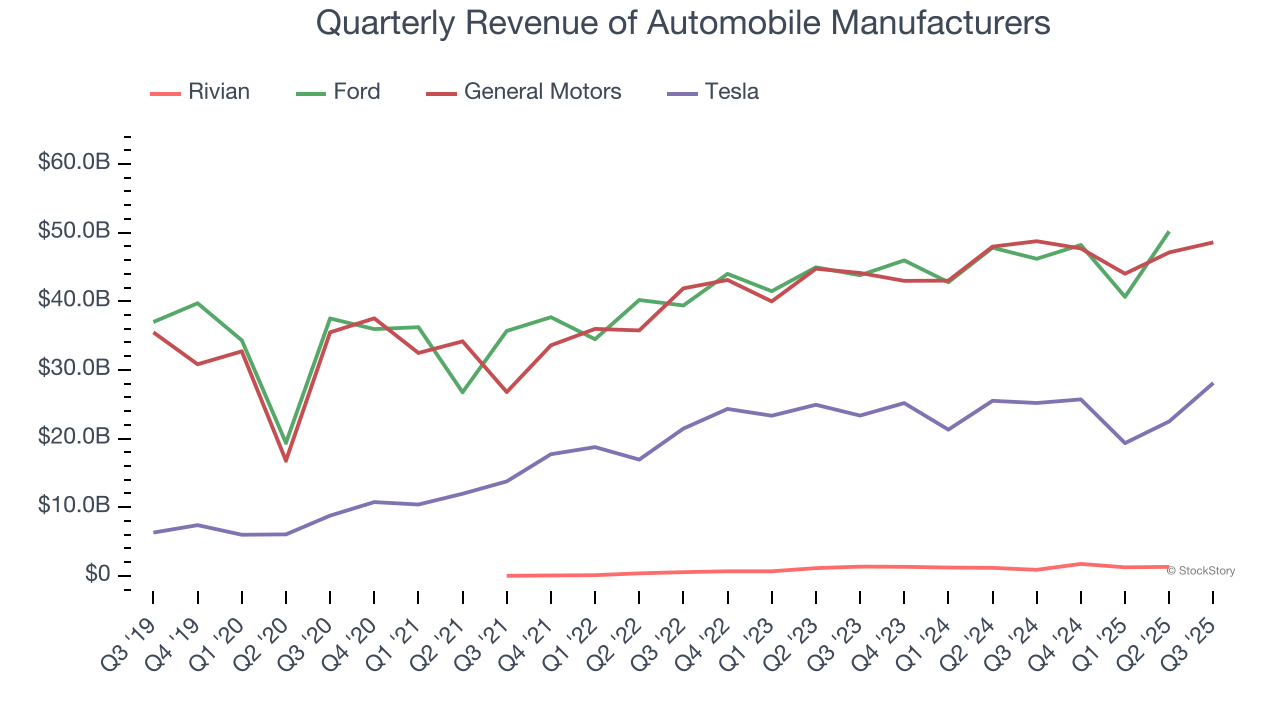
We at StockStory emphasize long-term growth, but for disruptive companies like Tesla, a half-decade historical view may miss emerging trends in autonomous vehicles and energy. Tesla’s recent performance shows its demand has slowed significantly as its revenue was flat over the last two years. 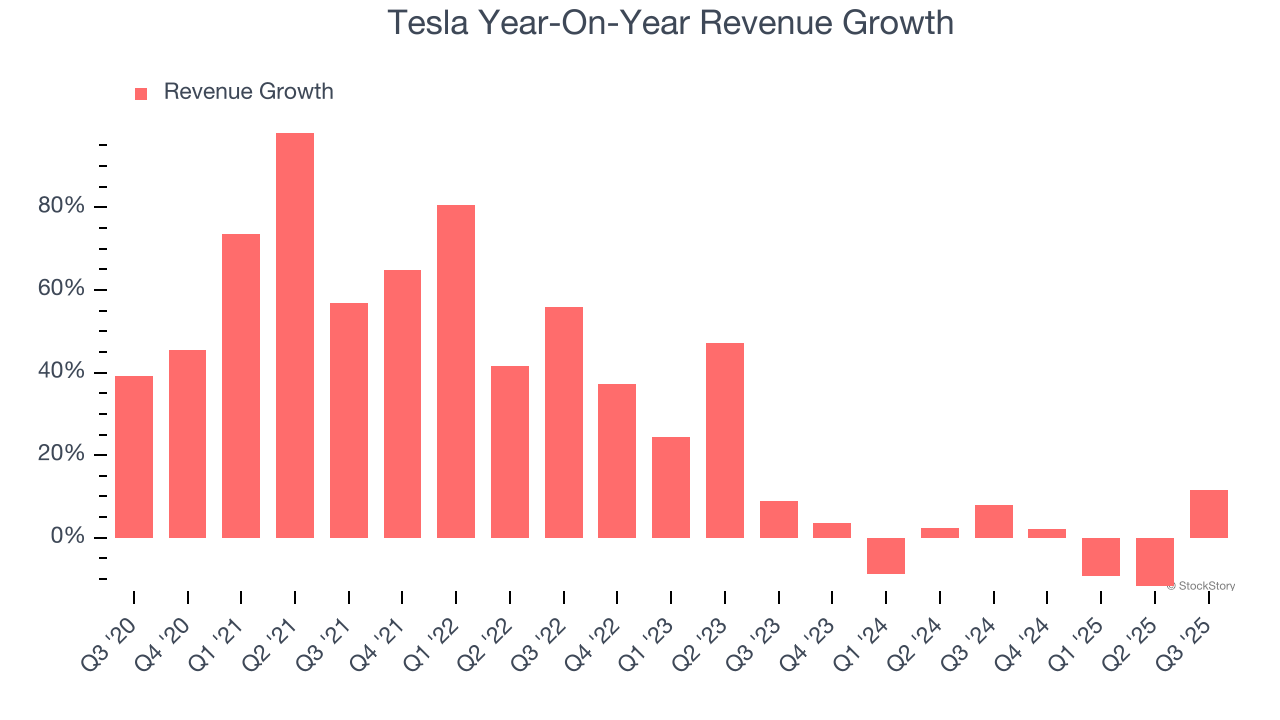
This quarter, Tesla reported year-on-year revenue growth of 11.6%, and its $28.1 billion of revenue exceeded Wall Street’s estimates by 5.7%. Looking ahead, sell-side This projection is healthy for a company of its scale and illustrates the market is baking in some success for its newer products.
Software is eating the world and there is virtually no industry left that has been untouched by it. That drives increasing demand for tools helping software developers do their jobs, whether it be monitoring critical cloud infrastructure, integrating audio and video functionality, or ensuring smooth content streaming. Click here to access a free report on our 3 favorite stocks to play this generational megatrend.
Automotive: Act One
Revenue: The Race For Dominance
Tesla is primarily an automobile manufacturer today and generates 74.9% of its revenue through the sale and leasing of EVs. It historically produced expensive, high-end EVs, but after years of operating losses, has shifted its focus to the mass market with affordable vehicles. The Model 3 and Model Y (released in 2017 and 2019) are the headliners of this story, and we’ll dive into their impacts below.
Over the last five years, Tesla’s vehicles sold grew by 31.8% annually to 1.71 million units in the last year. This is meaningfully above the its 24.1% annualized growth rate for Automotive revenue, implying that its average vehicle price fell.
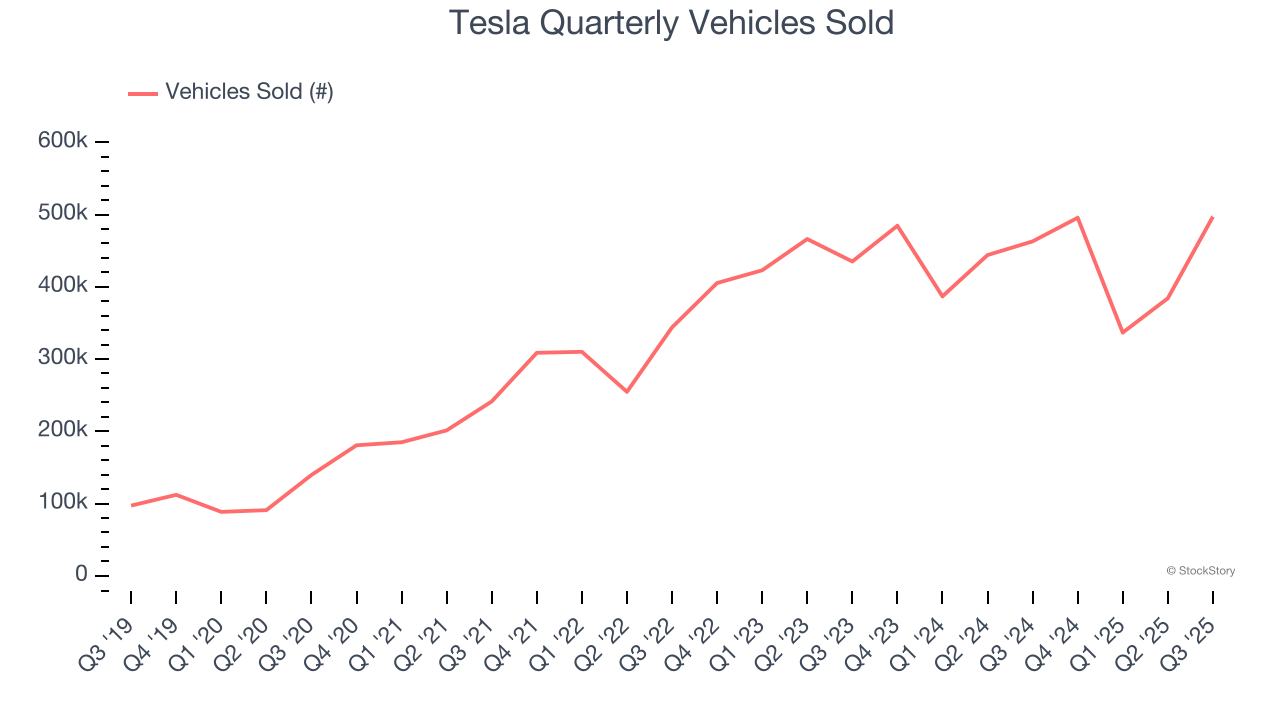
Specifically, Tesla's average revenue per vehicle sold was $41,805 for the trailing 12 months, noticeably lower than the $56,348 price tag in 2020.
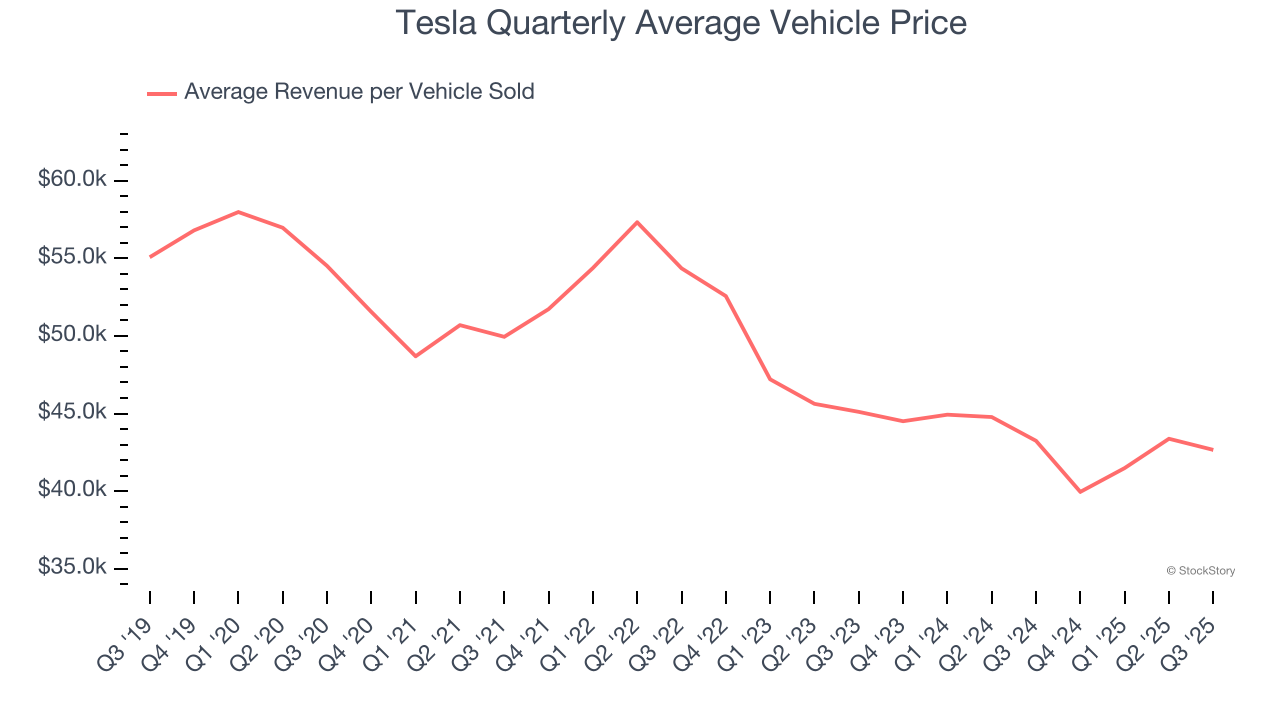
These unit and pricing trends uncover three facets of the company’s automotive business:
1) It has achieved its goal of selling more Model 3 and Model Y vehicles, which carry lower price tags than other models, 2) the scaling production of its mass-market models is boosting manufacturing efficiency because it lowers the fixed cost per vehicle sold, and 3) rather than increasing profitability by reaping the cost-saving benefits, Tesla is passing them to customers through price reductions.
In Q3, Tesla’s vehicles sold rose by 7.4% year on year to 497,099 units, beating Wall Street’s expectations. Putting this print side-by-side with its 5.9% Automotive revenue growth suggests an average vehicle price of $42,657, similar to the same quarter last year.
Unit Economics: The Impact Of Price Cuts
There’s no denying automobile manufacturing is a tough business. Few upstarts succeed because incumbents like General Motors and Ford can afford to break even on the initial sale of vehicles and instead make money on parts and servicing, which come many years down the line. This is why new entrants such as Rivian have negative gross margins - they must price competitively, and their fleets are too young to generate substantial aftermarket revenues.
Tesla does not disclose the operating profitability of its segments, but we can analyze the gross margins of its various divisions to see how it stacks up. For Automotive, this metric reflects how much revenue is left after paying for the raw materials, components, and direct labor costs that go into manufacturing and producing its vehicles.
Thankfully for investors, Tesla has crossed the chasm as its Automotive segment boasted an average gross margin of 22.4% over the last five years. While it may be low in absolute terms, Tesla’s margin was best in class for the industry and illustrates its superior pricing power and procurement capabilities. Its breathing room also explains why the company can squeeze its competitors by slashing prices.
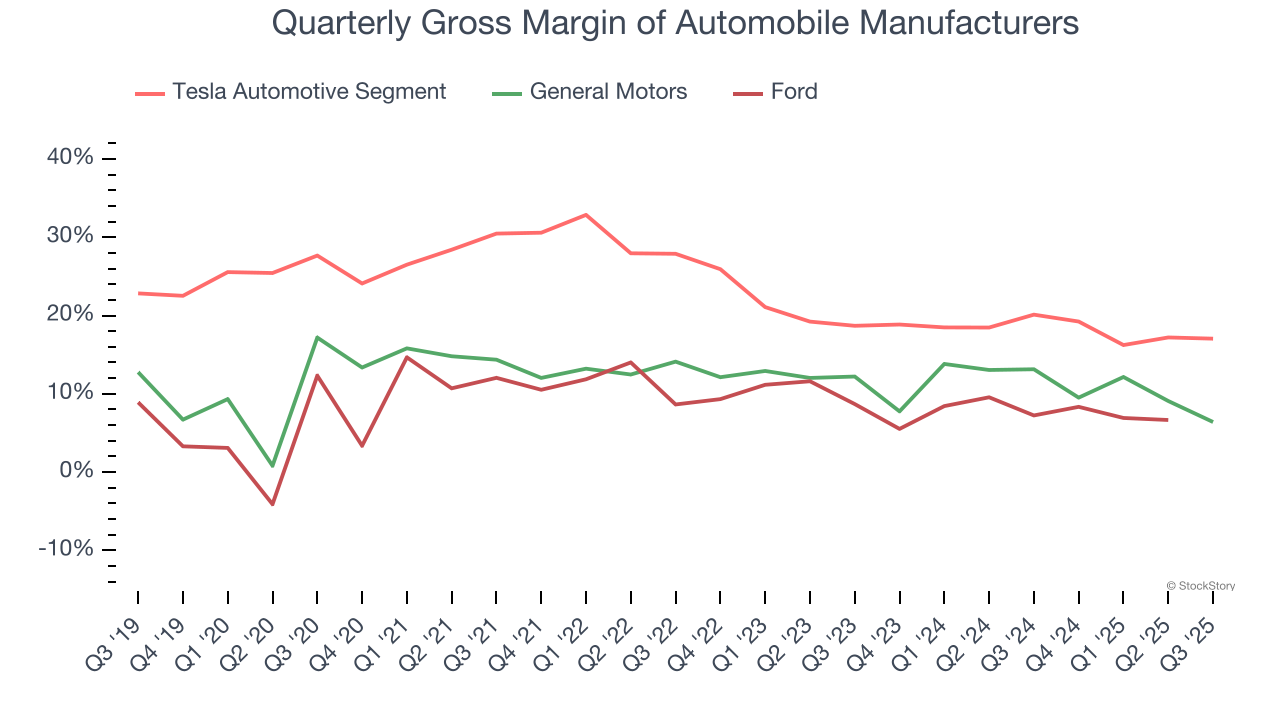
Looking under the hood, Automotive’s annual gross margin fell from 25.4% five years ago to 17.5% in the last year. This is a direct result of its price cuts and shows the company is sacrificing higher profits today to increase its installed base and potentially secure longer-term recurring revenue streams. The trend slightly improved this quarter as its gross margin stabilized, but we wouldn’t put too much weight on short-term results.
Key Takeaways from Tesla’s Q3 Results
We were impressed by how significantly Tesla blew past analysts’ revenue expectations this quarter, positing growth after two quarters of decline. We were also happy its revenue narrowly outperformed Wall Street’s estimates, as Automotive and Services beat while Energy was in line. On the other hand, its gross and operating margins were down year-on-year, and EPS missed. Overall, this print was mixed. The market seemed to be hoping for more, and the stock traded down 1.4% to $432.40 immediately following the results.
Should you buy the stock or not? The latest quarter does matter, but not nearly as much as longer-term fundamentals and valuation, when deciding if the stock is a buy. We cover that in our actionable full research report which you can read here, it’s free for active Edge members.
